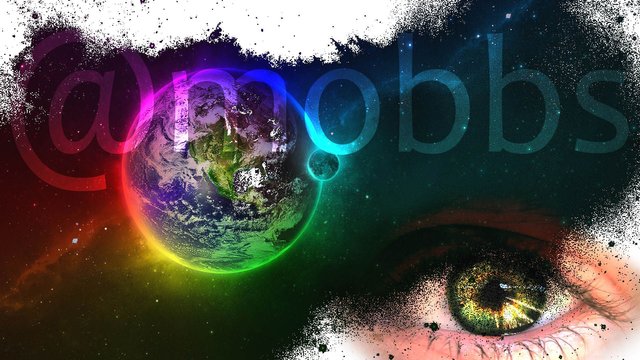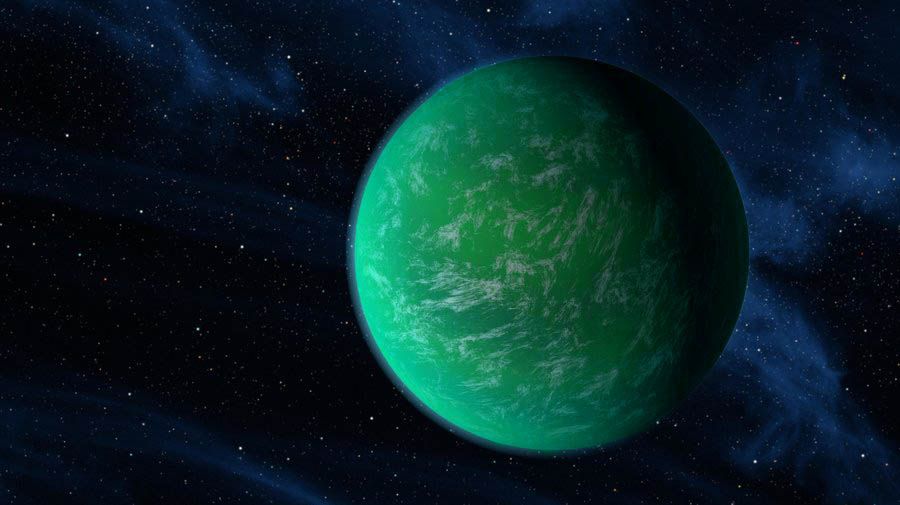
- Direct imaging
- Watching the change of light as planets pass in front of stars aka, the transit method
- Gravitational Microlensing
- Observing the wobbles of stars as planets affect their orbits slightly
- Other innovations on them.
One particular thing about the 'transit method' and 'direct imaging' is that not only can they detect that a planet exists, but they're also quite good at detecting its size, distance from the star, speed and, most interesting of all, chemical composition. using spectroscopy, we can determine what colour those planets would be if we were floating around at a moon's distance.
Some of those 3,000 discovered exoplanets look frankly wonderful, and others evil. I'll let you decide which, then I'll discuss how this can help us search for life.
GJ 504b: The Pink Planet

As far as planetary hues go, pink is a winner if you ask me. But why? Simply put, it's hot.
The planet happens to have been the first exoplanet directly imaged, which is one of the most difficult methods to see planets at all. The atmosphere was seen to have methane, and it was approximately 45 times further from its star than the Earth is from the Sun. That's way beyond Neptune's orbit, at merely 30 AU.
Hang on...If it's so far away, how is it so hot, I hear you ask. After all, its sun is less luminous than our own. Well, although it's one of the oldest planets discovered by this direct imaging method, it's still pretty young, somewhere between 100-500 million years old. It's still hot from its very formation, around 250°C.
That being said, the planet poses some conundrums about how it exists in the first place, since its distance defies our understanding of how gas giants form within the dense clouds of gas much closer to their stars.
55 Cancri e: The Diamond Planet

Yes, a planet of diamond. This poses some problems for humanity. If we manage to easily mine this and similar planets, our engagement rings will become worthless!
I doubt we will harvest such a planet though, as it is an extreme super earth. 8 times as massive yet only twice the size of Earth, it orbits its sun-like star in barely 18 hours. That means its so close to its sun that it's tidally locked, with a facing temperature of around 1,700°C.
Not very welcoming.
It does have as slight sunny atmosphere of Hydrogen and Helium, and its thought to be made up of 30% carbon. When carbon falls under intense heat and pressures, you get diamond, and a planet 8 times more massive than Earth has plenty of heat and pressure.
Oh, it's also actively volcanic. I like to think it spits out diamond rings.
TrES-2b: The Planet of Darkness

This planet is quite literally darker than coal. A deep black that reflects almost no light whatsoever, despite its blistering 1,200°C climate. To compare, Earth reflects about 37% of light. Jupiter, 52%. TrES? around 0.04%.
Part of this is due to it being too hot to have any reflecting cloudy atmosphere but that doesn't explain it entirely. Mercury isn't that dark. We're talking blacker than black paint. The true answer is still unknown, but it's theorized that there's some exotic chemistry going on in its thin atmosphere, such as the light-absorbing components of vaporized sodium, potassium, and gaseous titanium oxide.
How colour can help us find life
Earth-like planets could be green, Water worlds (as discussed in an earlier episode) are blue, others are red, pink, black, brown, and so forth. They kinda look like these petri dishes full of microbes

The theory goes that by looking at the hue of colourful planets, we could quite literally be staring at a microbial-dominated world. The chances are much slimmer that we'll be finding giraffes and snakes compared to that of much hardier microbes that have been found thriving in the most extreme conditions here on Earth; undersea volcanoes, oversea volcanoes, icy tundra, thousands of metres underground, covered in sulphur, desolate deserts, deep space and so on. Even the most toxic, acidic lakes and uninhabitable salty seas have been found with thriving bacteria, some of which have even mutated to chomp away on plastic.
Earth reflects infra-red light from the view in space, which is bouncing off chlorophyll from all our luscious plants. This could also be a result in exoplanet discovery.
So next time you want to look for life outside of our own, look for the pretty colours out there in the vast, darkness of space.

Thanks for reading!
Image Sources:
Pink Planet
Diamond Planet
Black Planet
Microbes
Green Planet Art
Water World
Eyeball Earth
Extreme Exoplanet Weather of Death and Doom
Planet as old as the Universe
Strange Star Systems
Mystifact - What is a planet?
How to Find Exoplanets
The scientific discoveries that concern outer space are surely fascinating to read since they excite the imagination for the unknown mysteries of cosmos, even to people that do not ardently follow the news and know the details related to them. I believe 2018 will be a truly fascinating year due to the launch of the JWST(James Webb Space Telescope) which will undoubtedly assist us to unravel many enigmas of the universe, since its penetrating gaze will be able among others to glimpse at the composition of the atmospheres surrounding many of the exoplanets you have mentioned and possibly give us clues about their potential for habitability. I believe the following years will be simply astounding!
Downvoting a post can decrease pending rewards and make it less visible. Common reasons:
Submit
Oh yeah the James Webb is gonna be amazing. I'm just worried that we've built it up for SO many years (I feel like I was still a kid when it was being talked about), it'll just crash in a bad rocket... argh!
Thanks for the thoughtful comment!
Downvoting a post can decrease pending rewards and make it less visible. Common reasons:
Submit
This is awe-inspiring.
Downvoting a post can decrease pending rewards and make it less visible. Common reasons:
Submit
https://steemit.com/@argd88
Downvoting a post can decrease pending rewards and make it less visible. Common reasons:
Submit
Ha I knew about the diamond planet from this pic I saw a while ago :D
To the dissapointment of some, we are not 100 % sure it's made of diamond.. Copy-theft from wiki: "much of which may be in the form of diamond as a result of the temperatures and pressures in the planet's interior. Further observations are necessary to confirm the nature of the planet"
Downvoting a post can decrease pending rewards and make it less visible. Common reasons:
Submit
Yep right, although there's actually more than one; a second was discovered with the even catchier name 'PSR J1719-1438 b'. I didn't want to use this one though because there are some other... awesome things about it that I don't want to discuss just yet.
But it's supposedly a whole new class of 'carbon planets' that we may have stumbled across.
Downvoting a post can decrease pending rewards and make it less visible. Common reasons:
Submit
GJ 504b looks like something straight outta DBZ. Exoplanets are so beautiful and mysterious! I am hoping that out there in the trillions of galaxies there is an exoplanet with a solid layer of chocolate. Or it rains chocolate (queue chocolate rain). Or there are chocolate oceans..... I'll stop now.
Downvoting a post can decrease pending rewards and make it less visible. Common reasons:
Submit
Well we have found some complex molecules out there, maybe C7H8N4O2 is possible! Never give up hope!
Downvoting a post can decrease pending rewards and make it less visible. Common reasons:
Submit
Haha I hope so, to infinity!
Downvoting a post can decrease pending rewards and make it less visible. Common reasons:
Submit
This post has received a 4.52 % upvote from @buildawhale thanks to: @trumpman. Send 0.100 or more SBD to @buildawhale with a post link in the memo field to bid on the next vote.
To support our curation initiative, please vote on my owner, @themarkymark, as a Steem Witness
Downvoting a post can decrease pending rewards and make it less visible. Common reasons:
Submit
Thinking about color when looking for life outside the Solar System was quite a novel concept I was very happy to read about.
Downvoting a post can decrease pending rewards and make it less visible. Common reasons:
Submit
Glad you enjoyed it =)
Way cooler stuff to come!
Downvoting a post can decrease pending rewards and make it less visible. Common reasons:
Submit
Can't wait then :)
Downvoting a post can decrease pending rewards and make it less visible. Common reasons:
Submit
Digging the editing skills in the thumbnail my dude!
Downvoting a post can decrease pending rewards and make it less visible. Common reasons:
Submit
Ohhh thanks, you're the first to even mention my thumbnails! =D
Downvoting a post can decrease pending rewards and make it less visible. Common reasons:
Submit